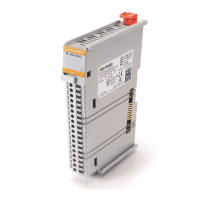60 Rockwell Automation Publication 5000-UM005B-EN-P - November 2015
Chapter 4 Current/Voltage/Temperature-sensing Analog Input Module Features (5069-IY4)
Underrange/overrange conditions are indicated when the following tags
change to 1:
• I.Chxx.Underrange
• I.Chxx.Overrange
For more information on how to use the module tags, see Appendix B,
Module
Tag Definitions on page 133.
Thermocouple
S < -50 °C
< -58 °F
< 223 °K
< 402 °R
> 1768 °C
> 3215 °F
> 2041 °K
> 3674 °R
N/A
T < -270 °C
< -454 °F
< 3 °K
< 6 °R
> 400 °C
> 752 °F
> 673 °K
> 1212 °R
TXK/XK(L) < -200 °C
< -328 °F
< 73 °K
< 132 °R
> 800 °C
> 1472 °F
> 1073 °K
> 1932 °R
D < 0.00 °C
< 32 °F
< 273 °K
< 492 °R
> 2320 °C
> 4208 °F
> 2593 °K
> 4668 °R
(1) Underrange is set at < 3 mA, but the I:Chxx.Data tag reports values as low as 0.0 mA. The condition is clamped when the signal
reaches 3 mA.
(2) The module has alarm deadband values for each range. The deadband lets a condition remain set despite it disappearing. For
example, if a module uses a Current input type in the 4…20 mA range and the signal value goes below 3 mA, the underrange
condition is triggered. Because of the 0.07 mA deadband, the condition is not cleared until the signal value reaches 3.07 mA.
For more information on Alarm Deadbands, see page 63.
IMPORTANT
The Disable All Alarms feature, does not disable the underrange/overrange
detection feature.
The Disable All Alarms feature disables alarms on the module.
Underrange/Overrange detection is not an alarm. It is an indicator that
channel data has gone beyond the absolute maximum or minimum,
respectively, for the channel range.
To disable the Underrange/Overrange detection feature, you must disable
the channel.
Table 16 - Input Type Underrange/Overrange Thresholds
Input Type Range - Current and
Voltage Input Type
Sensor Type - RTD
and Thermocouple
Input Type
Underrange
Threshold
Overrange
Threshold
Deadband
(2)

